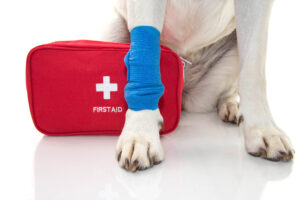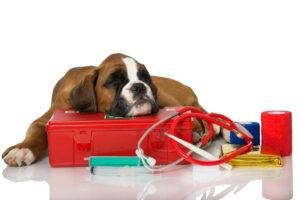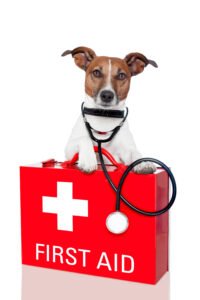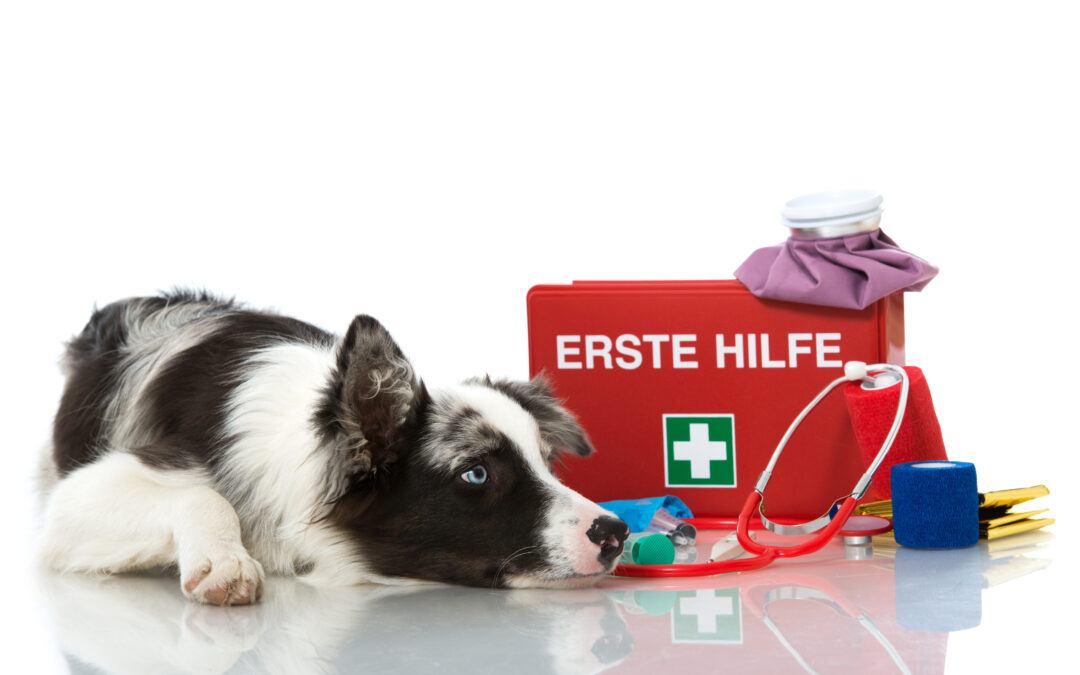LifeWithMyDogs is supported by our audience. When you purchase through one of our links, we may earn a small affiliate commission. As an Amazon Associate I earn from qualifying purchases. Your cost is not affected.
**********
Pet First Aid Tips For Your Dog
It is not strange to study pet first aid tips when you own a pet dog. One of your commitments after adopting your buddy is to take good care of it. It is your responsibility to see to its needs, especially in times of trouble. Knowing what to do when emergencies strike and having the things needed is important.
The last thing that you want to do when difficulties occur is to panic. Your loyal companion is dependent on you. So you need to be ready to respond right when it needs your help. This means that you must determine if it’s in trouble and take appropriate actions.

Buy Or Build Your Own Veterinary First Aid Kit
Crisis happens to our canine friends and there’s no telling what often occurs. Troubles take place at random. It would be smart for owners to at least have helpful things ready because of them. There ought to be items to address some of the most common canine emergencies.

Here are some examples of a list of things that you might find inside of a first aid kit used by veterinarians:
-
First Aid Manual. There is often a pocket guide with instructions inside. Inside are tips to identify signs of problems. There are also names of the usual conditions that need immediate intervention. Sometimes, it even has the contact information of veterinarians and pet care facilities. So it is one of the most essential things that need to be available.
-
Soft muzzle. Bringing this is very helpful on the count that it can stop a dog from biting. If your buddy can’t bite anymore then performing medical treatments may become faster.
-
Collar and leash. These are for an owner to always have control over his or her dog. They can prevent a pooch from running away and confine it in one spot. Plus, you may need to lead your dog to safety with these during an emergency.
-
Water and saline wash with a bowl or another container. Either liquid is crucial for washing and thus cleaning areas of a dog’s body. Yet it is only clean water that is for ingestion or hydration. A small bottle might be enough for emergency use.
-
Adhesive Tapes and Bandages. These are crucial to have for many reasons. They could help in immobilizing and covering certain parts of a dog’s body. So they are useful when a dog fell from high ground or got hit by a moving object. They could treat or at least provide relief for dislocations and fractures.
-
Cutting Tool. There ought to be a knife or a pair of scissors in an emergency response kit for canines. There may be a need to remove thick clumps of fur to better see an area. Tapes and bandages may also need cutting to better suit a dog. Yet the edges for clipping must always be sharp and reliable.
-
Antiseptic solutions. Examples of these are hydrogen peroxide, povidone-iodine, and isopropyl alcohol. Having at least two of these in your kit may be better to have options for your veterinary first aid kit. Yet you must know how to prepare and apply them even before any catastrophe takes place.
-
Lighting tools. A penlight can help illuminate small areas for better visualization. A flashlight allows for better lighting. It would be great to have both but having one will do.
-
Antibiotics and antimicrobial agents. These come in the form of pills, sprays, and gels. Some of them you can get without seeing a vet. You must consult an expert before buying the others. It’s only because these things that fight bacteria have unique properties. Some are way stronger in targeting pathogens but can cause adverse reactions. So look for the common medicines and read the labels first before administration.
-
Digital thermometer and canine sphygmomanometer. You may want to have these things because of their importance in assessment. But knowing how to use them is crucial too. It is imperative that you can not only put them right on your dog but also read and interpret the results.
-
Tweezers and magnifying glass. They are important for object extraction from a dog’s body. Tweezers can allow you to grip something small and then pull it out with less strain. A magnifying glass lets you better see the area that you’re working on.
Common Emergencies and The Pet First Aid Tips For Them
It isn’t too late to learn about these things when problems haven’t happened. So it would be wise to be familiar with the typical critical issues that arise to pet owners and their dogs. That is so you would know how to identify and do something positive about them.

These happenings may occur while you are around or during your absence. So you ought to know them and make preparations while you are ahead. It is so you could avoid panicking later and help your buddy manage and live longer.
-
Bites and Fight Wounds. Dogs sometimes become aggressive with one another during play so this happens. Often canines bite one another due to their territorial nature. When this occurs, check your pet for open wounds and painful areas. Apply water or saline and wrap the affected sites. Take your buddy to the nearest vet for medical intervention.
-
Difficulty Breathing or Choking. Check the airway of a dog to know if there’s anything at all that is blocking it. Remove an object from a dog’s mouth or perform the Heimlich maneuver. Break the object into pieces if you have to. Do rescue breathing or take your pet to a vet for oxygenation if necessary.
-
Unconsciousness. For this, you may have to assess first. Try calling or shouting to see if the dog responds. Listen for its heartbeat and feel its pulse, and note if there is a chest rising and falling. Deliver air by rescue breaths if the dog isn’t breathing. Give chest compressions with rescue breathing if there is no pulse or heartbeat. See expert guides of these for the specifics.
-
Burns. See the severity and immediately immerse the dog with burns in cool but not freezing water. If that isn’t possible yet then at least spraying the burnt areas with cold water will help. Hurry and bring your pet to a vet for proper treatment. There may be a need for serious hydration.
-
Internal or External Bleeding. See where a dog bleeds first. Try to stop it by applying compressions. Yet if the bleeding is internal then going to a veterinarian is more appropriate. A vet may operate on the canine to see the seriousness of the issue.
-
Seizures. These become an emergency when the seizures last longer than 5 minutes. A vet examines a pooch and may give phenobarbital or potassium bromide as necessary.
-
Anaphylaxis. Do not delay and get help when a dog shows signs of severe allergic reaction. It may be important to administer anti-allergic medications such as epinephrine and steroids. Severe itching, excessive salivation, vomiting, and skin discoloration are some of the signs.
-
Bloating. This is a medical emergency because it can result in intestinal torsion for the dog. When you suspect that your pet experiences this, go to the nearest vet. The expert may give you simethicone to address the issue or at least suggest some diet changes.

Always Have A Reliable Veterinary First Aid Kit and Pet Care Skillset
Knowing about pet first aid tips can be quite helpful. But what can give peace of mind is having enough and the right supplies. Also, it is being capable of using those items in times of crisis. Here are more details about these points:
-
Check the expiry date of your first aid kit supplies. Change the ones that expired and find dependable substitutes for them. Also, consider getting replacements for defective or unreliable tools. You should even examine the bag that has them all to make sure that it is dependable.
-
Try counting the type of supplies available and reorienting yourself with them. This includes recalling their purpose and how it would be best to use them. You’ll know or remember where they are better and what they are for in doing these things.
-
It would be great to have updated information about emergency response skills. Trying to practice what you learned even by simulating events is helpful. This approach would at least give you muscle memory to respond fast when needed.

To Conclude
Reading about pet first aid tips can improve one’s emergency preparedness. Doing so may help a pet owner invest in the right stuff. It may also aid in improving a person’s response time and type to dog emergencies. So you can say that studying the topic can make you equipped.
It may be interesting and useful to know these things as a dog owner or lover. Yet learning those first aid tips by heart is essential. To do that, one needs to review these lessons from time to time. This includes assembling a kit and practicing some pet first aid tips and skills.



